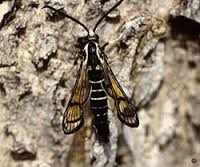Add another insect to the list of reasons to keep ash trees healthy: lilac/ash borer.
Because lilac/ash borer is native to North America, it has had thousands of years to make itself at home in its favorite tree and is therefore the ash’s most common pest. The tree pest most often
Adult lilac/ash borer emerge in early April to early may, depending on seasonal temperatures where they over winter. Their favorite temperature is right around 60 degrees and once temperatures are consistently near that mark, adult lilac/ash borers begin to emerge. As the adults make their way out of their winter home, their pupal skin sometimes stays behind, sticking out of the tree trunks. This makes infested trees easy to spot.
The adults most commonly fly on warm mornings, but only for about four to six weeks after emerging. They are often mistaken for bees or wasps, due to their striped, slender bodies and transparent, black-lined wings.
Following mating, females lay single or small groups of eggs in bark crevices on lower tree trunks. In less than two weeks, the eggs hatch and larvae eat their way into the trunk. Over the summer, fall and early winter, the larvae tunnel their way up the trunk. In late winter, they move just under the bark to start their life cycle again as soon as temperatures warm up.
Although lilac/ash borer doesn’t cause as much damage as emerald ash borer, any damage to an already stressed tree can result in loss of the tree. If you suspect any type of ash borer infestation, contact SprayTech, Colorado commercial and residential tree specialists, at 720-248-0000 for a tree inspection and treatment plan.
Comments are closed.